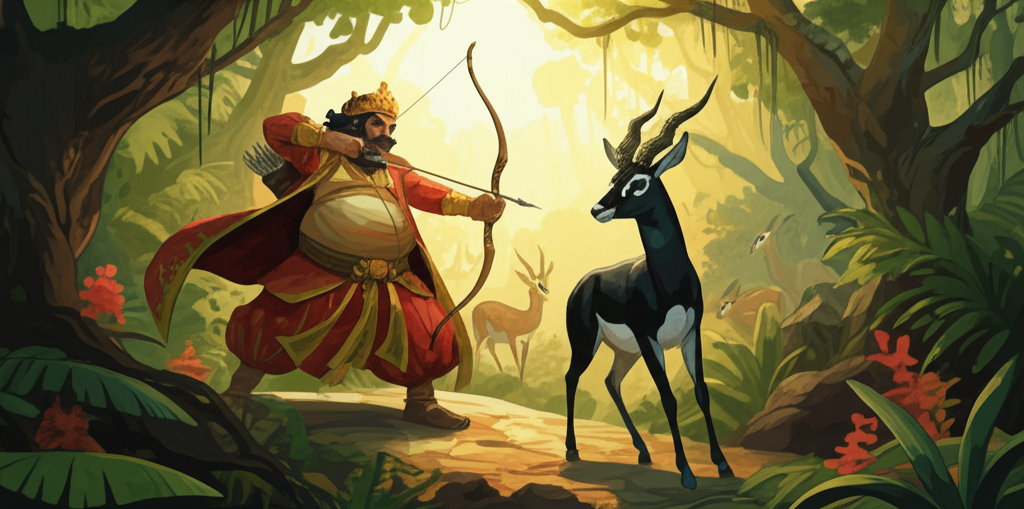
Once upon a time, there was a king named Burtal who was very important. He had a hundred and sixty wives, but he didn’t have any kids, which made him super sad. One day, he told his wives, “I’m going on a trip to a faraway jungle to hunt for antelopes!” They said, “Okay, have a good time!” So, he went. In that jungle, there weren’t any tigers or people, just lots of antelopes.
When King Burtal got to the jungle, some of the antelopes came up to him and said, “Please don’t hurt the black antelope because he’s our leader, our king! We don’t have another antelope like him. But you can hunt any of the other antelopes, like the brown or yellow ones.” But King Burtal wasn’t very nice, and he said, “I’m going to hunt your black antelope, and no one else!” And he shot him! The black antelope fell to the ground.
When the other antelopes saw what happened, they started crying and making sad noises. But the dead antelope’s wife told them, “There’s a wise, holy man in the jungle! Let’s take our king’s body to him and ask him to bring him back to life!” King Burtal just laughed and said, “How can anyone bring a dead antelope back to life?” But the antelopes put their dead king on their backs, and his wife walked in front, leading the way. King Burtal followed along too. They carried the body to the wise man, whose name was Goraknáth. He was resting in the jungle. They said to him, “Please bring our king back to life! What will we do without him? He doesn’t have any sons to take his place!” And the queen antelope said, “He’s my only husband! Please bring him back!” King Burtal just laughed and made fun of them, saying to the wise man, “I’ve never heard of anyone bringing a dead antelope back to life! I don’t think you can do it!”
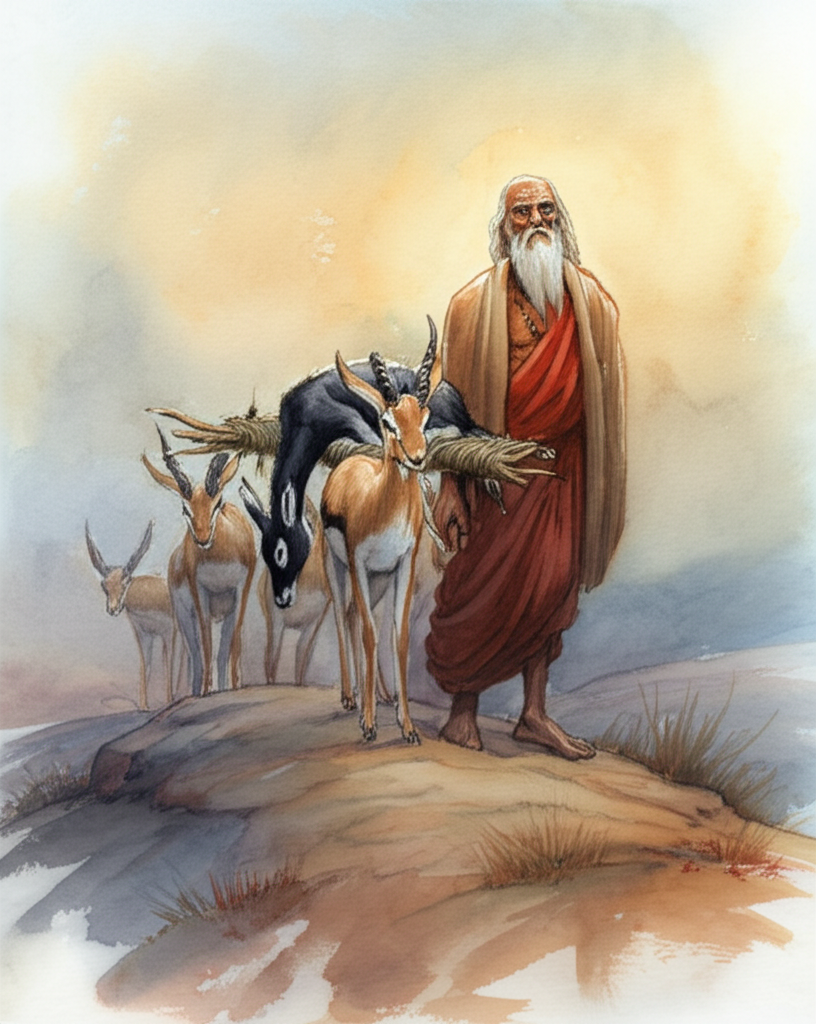
This made Goraknáth a little mad. He knelt down and asked God to bring the antelope back to life. God told him to take a stick and tap the dead antelope with it, and then he would come alive again! So, Goraknáth took a stick and tapped the dead antelope, and suddenly, he was alive! The antelope jumped up and flew away into the sky! The antelopes were super happy to see their king alive again, and they said, “We don’t mind that he went up to the sky. He’ll come back to us someday!”
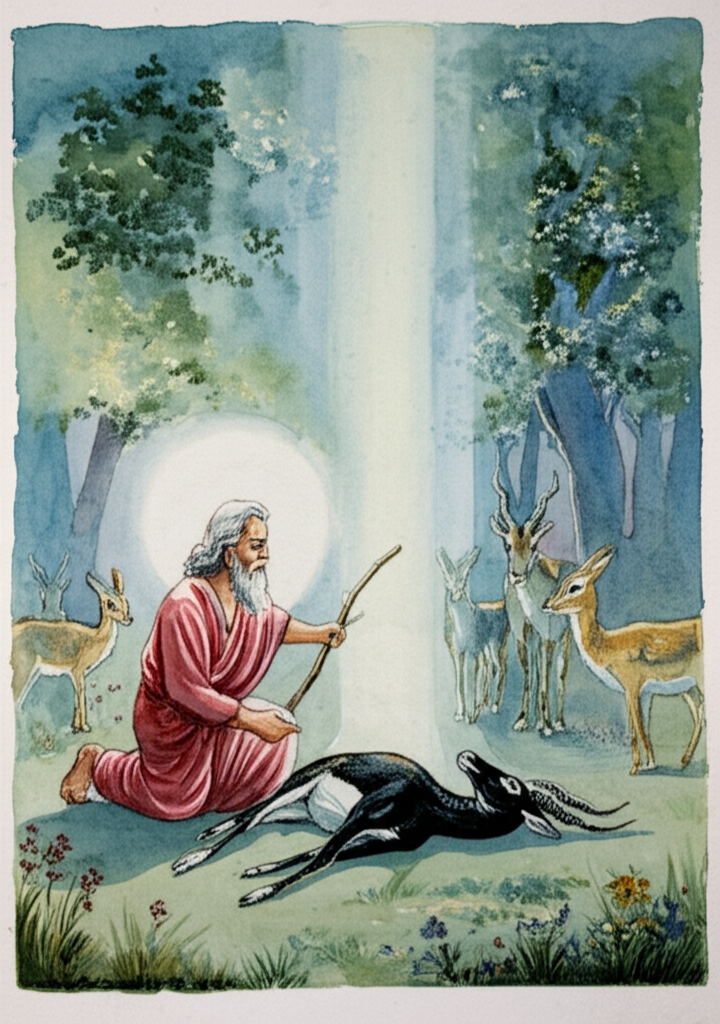
King Burtal had been watching the whole time. He said to Goraknáth, “Make me a wise man like you!” He thought it would be amazing to do such wonderful things. But Goraknáth said no. King Burtal stayed in the jungle with Goraknáth for twelve whole years, always begging and asking to become a wise man. Finally, Goraknáth said, “I can’t make you a wise man unless you go home and call your wives ‘Mommy,’ and ask them for money and food.” Now, it was a very silly thing to call your wife ‘Mommy’ because if you did, she would have to leave you. Then, Goraknáth took off King Burtal’s fancy clothes and gave him a simple cloth and a tiger’s skin to wear. The king went back to his palace and started asking for rice and food. He wouldn’t take any from the palace helpers; he said he had to see the queens and that they had to give him the food themselves!
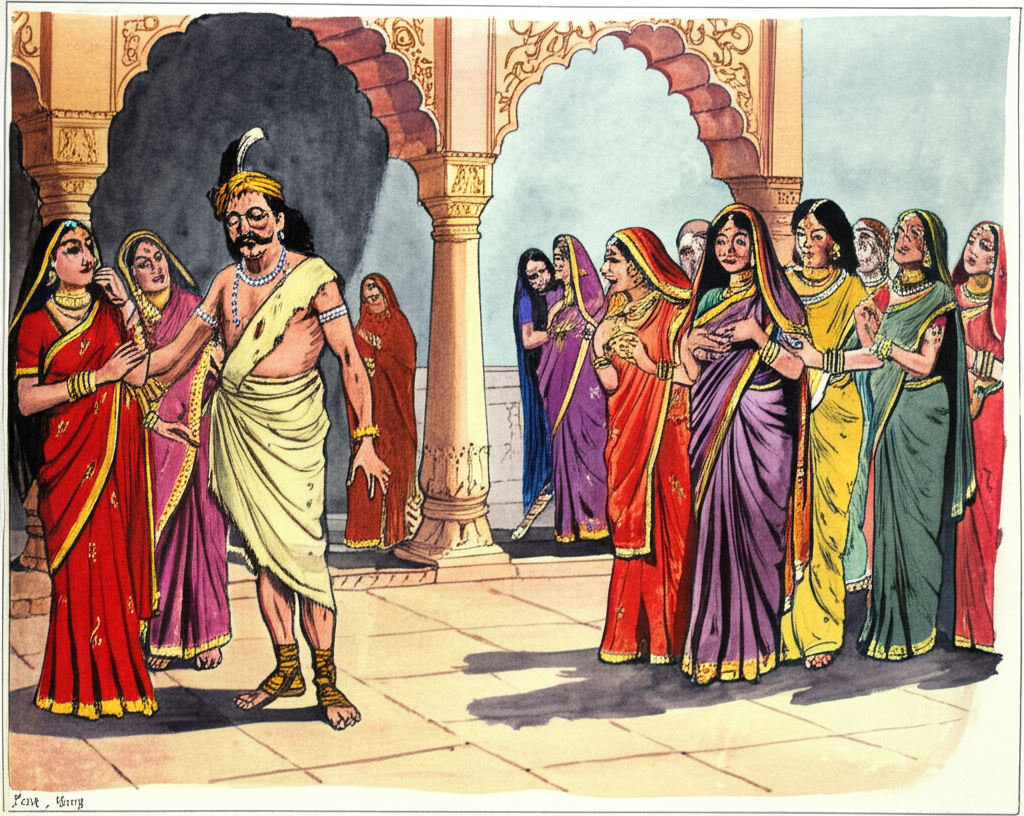
The helpers told the queens about this strange man who wanted to see them and get food from them. One of the maids, who recognized King Burtal, told the queens that the strange man was their husband, who had been gone for twelve years! The queens shouted, “That’s nonsense! That can’t be our husband!” The maid said, “Go see for yourselves!” They went to see, and the strange man said to them, “Mommy, give me rice!” They said, “Why are you calling us ‘Mommy’? We don’t have any sons! You’re not our son!” But then they realized it really was their husband! They started crying and threw themselves on the ground, saying, “Why did you call us ‘Mommy’? Why are you asking for food? Now we have to leave you!” The king said, “Don’t go! Take my kingdom, my money, my houses, and stay here until I get back. I’m going to be a wise man!” His wives gave him some rice and some money, and he went back to Goraknáth.
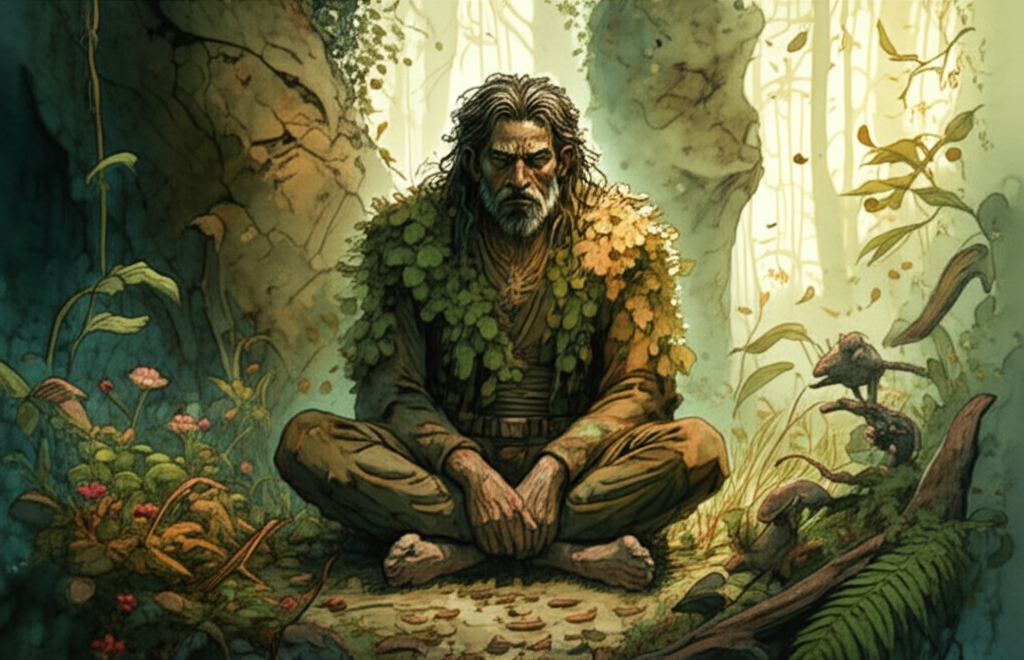
Long ago, people who wanted to become wise men had to do three tasks given to them by another wise man. So, Goraknáth told the king, “Now you have to go to a jungle that I’ll show you and stay there for twelve years.” King Burtal grabbed the pan and rolling pin he used for making flatbread and got ready to go to the jungle. But the wise man stopped him. “You have to leave your pan and rolling pin behind,” he said. “And for these twelve years, you can’t eat or drink anything, or you’ll never be a wise man. You have to sit perfectly still in the same spot and never move.” “I’ll die if I don’t eat!” said the king, “but I don’t care if I die, so I’ll do whatever you tell me.” Then the wise man took him to a jungle and made him sit down on the grass. Right away, the grass grew super tall and thick all around him, so King Burtal was hidden, and no one could see him. He stayed there for twelve years, never moving, eating, or drinking, and nobody knew he was there.
After twelve years, Goraknáth came and took him away. He said, “Now go home to your wives.” “Why should I go to my wives?” said King Burtal. “I don’t want to see them because they haven’t given me any children!” But Goraknáth said, “Go and see them.” So, King Burtal went. He asked them for rice, and they begged him to stay with them, but he wouldn’t. “I’m going back to the wise man Goraknáth,” he said. “Why should I stay with you? You’ve never given me a child. What good is all my money to me? I don’t have a son to give it to when I’m gone. I want to be a wise man!” They threw themselves on the ground and cried, “Oh, why do you want to leave us?” He said, “Because I want to!” He called them all “Mommy” and told them to stay in his palace and use all his stuff for themselves. Then he went back to Goraknáth.
“Now,” said Goraknáth, “you have to learn to be the cleaner for all the animals in the jungle, and you have to take care of them for twelve years.” So, for twelve years, King Burtal cleared the grass and kept the jungle clean for all the animals that lived there: cows, sheep, goats, tigers, cats, and bears! Sometimes he stayed in one part of the jungle and sometimes in another.
When the twelve years were over, he went to Goraknáth, who said to him, “Good job! You’ve learned to take care of the wild animals. Now you have to learn to take care of people.” Then the wise man took the king to a village and told him to sweep it and keep it clean for twelve years. King Burtal stayed there for another twelve years, and he was the village cleaner, keeping the village nice and tidy. He swept all the dust and dirt into a big pile until the pile was as tall and big as a house!
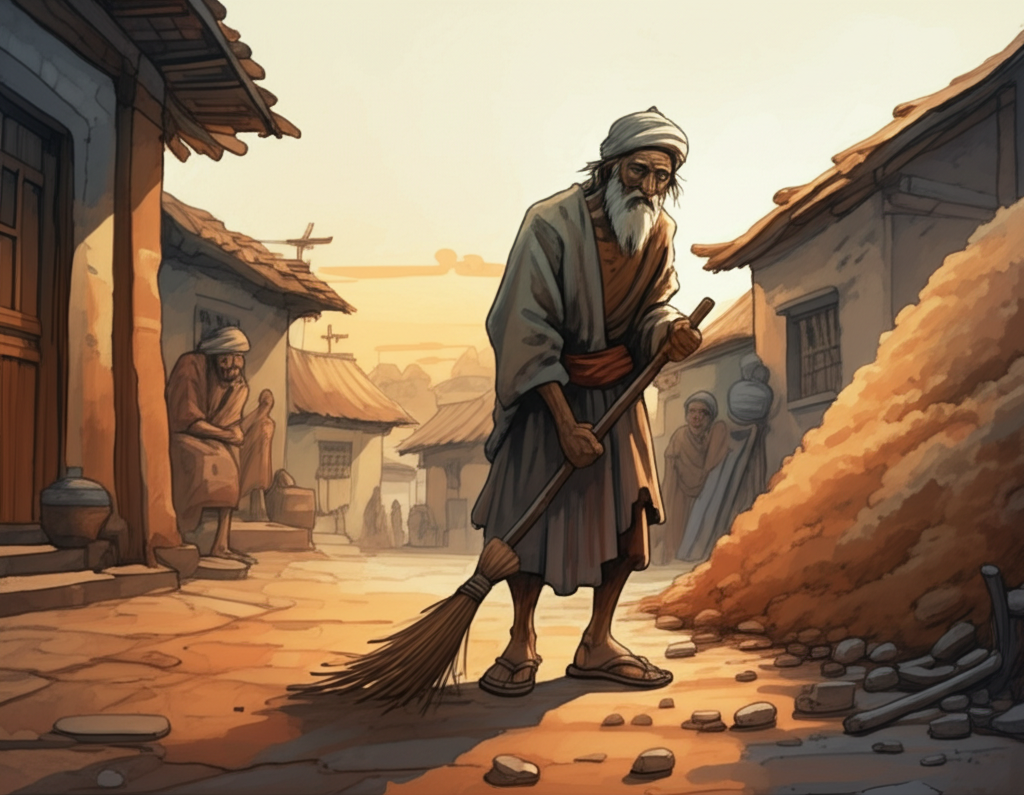
When the twelve years were over, he went back to Goraknáth and stood in front of him. While he was standing there, a man who was an angel sent by God came and threw some dirt on King Burtal’s head. But the king didn’t move or say anything. “Now,” shouted Goraknáth, “I see that you are a true wise man! Go wash yourself in the river!”
The river he was sent to wash in was called the Jamná. Water fairies lived in this river, and the fairy Gangá was playing in it when her sister Jamná came to her and said, “Come quickly! Our father is sick and wants to see you!” And Jamná went to her father. Gangá was hurrying after her when King Burtal saw her. He stopped her and asked where she was going so fast. “To my father, who is very sick,” said Gangá. “Let me go!” “I won’t let you go!” said King Burtal. Then Gangá started running and said, “You can’t keep me! You can’t catch me! No one can catch me!” This made King Burtal angry, and he said, “I can catch you, and I can keep you!” “No, no,” she said, “no one can catch me or hold me!” King Burtal got really annoyed, and he ran until he caught her. Then he said, “Now I won’t let you go! I’m going to keep you!” He held her in his hands and rubbed her between his palms. When he opened his hands, she had turned into a tiny round ball! He tried to hide the ball in his hair, but he couldn’t because his hair was too short. He realized he couldn’t hold Gangá because she was too strong for him. He decided to take her to Mahádeo, who had long, thick hair, and ask him to keep her. King Burtal was very scared and didn’t want to let the ball go because he knew Gangá was very angry and might turn back into herself and cause a big flood to drown him!
He ran quickly to Mahádeo and gave him the ball. Mahádeo asked, “Why don’t you keep her yourself?” “I can’t,” said King Burtal, “because my hair is too short to tie her up in. I can’t hold her because she’s too strong for me. But your hair is long, so you can hide her in it!” Then Mahádeo had a round box made of bamboo. There was a hole in the box, and he dropped the ball inside. He let down his long hair, which reached to the ground and was super thick. He put the box in his hair on top of his head and wrapped his long hair all around his head and over the box, like a turban!
Jamná realized her sister hadn’t followed her. She came up from the bottom of the river to look for her. She asked if anyone had seen her, and finally, someone said, “King Burtal took her away!” Jamná went to King Burtal and said, “Give me my sister Gangá! Our father is sick and wants to see her!” “It’s true that I took her away,” said King Burtal, “but I don’t have her now. She’s with Mahádeo.” So, Jamná went to Mahádeo. “Give me my sister quickly! Our father is sick and wants to see her!” (Now, Gangá was super mad inside her box.) “I can’t give you Gangá,” said Mahádeo, “because she’s so angry that if I let her out, she’ll flood the whole country!” “No, she won’t!” said Jamná. “If I give her to you, you won’t be able to keep her,” said Mahádeo. “Yes, I will!” said Jamná. “I don’t think you will,” said Mahádeo, “but here’s the box she’s in. Hold it tight and be careful not to say her name or let anyone else say it while you’re traveling!” Jamná said she would be very careful and took the box. But she had to go through a jungle where there were lots of cow herders and holy men. One of the holy men was named Gangá. Just as Jamná passed by, one of the other men called to the holy man by his name, “Gangá!” Right away, Gangá broke out of the box and flooded the whole country! The holy men and the cow herders begged her to have pity on them, and so did Jamná. But Gangá was too angry to listen or speak to them. She drowned all the holy men and the cow herders! When she got to her father’s house and found out he had died, she was so angry that she said she would send an even bigger flood to ruin the country! And she did!
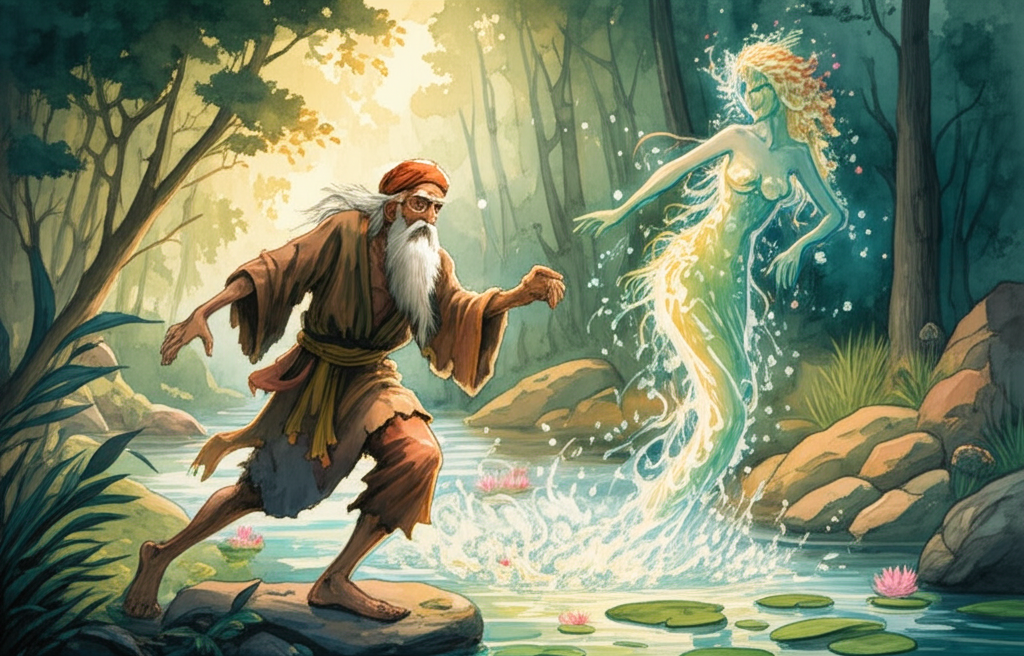
After this, King Burtal went to Goraknáth and stayed with him for a few years. Then Goraknáth said, “Now go back to your own kingdom.” But King Burtal said no, “I want to stay with you. My wives have never given me a child. I don’t have a son. I don’t want to go back to my kingdom.” But Goraknáth wouldn’t let him stay. “Go back to your own kingdom,” he said again. “But first, tell me how many wives you have.” “A hundred and sixty,” answered the King. “Here are a hundred and sixty líchí fruits for you,” said the wise man. “Give one to each of your wives to eat, and they will each have a son, and I will go with you!” So, King Burtal did what he was told, and Goraknáth went with him.
Seventy years had passed since King Burtal had left his kingdom. When he and Goraknáth arrived, they went to an open field, made a fire, and sat down beside it. Everyone who walked by said, “Who are these wise men?” Some of King Burtal’s queens’ helpers walked by, too. When they got home, they told the queens that their husband had come back to his kingdom! But the queens said, “That’s nonsense! King Burtal left with the wise man Goraknáth!” The helpers said, “We’re sure that King Burtal is here because Goraknáth is here, and there’s another man with him, and we’re sure that man is King Burtal!” So, all the queens went to see for themselves. When they saw the wise man with Goraknáth, they knew it was their husband! The first queen was very angry with him for leaving them. She put a spell on him, saying, “God is very angry with you for leaving us, and he will make you sick!” But King Burtal said, “Don’t be angry with me! I’m your husband, and I’ve come back to you after being gone for seventy years!” The youngest queen was very happy! She told the drummers to start drumming, and she drummed herself! They all sang songs and went to the palace together, with Goraknáth too!
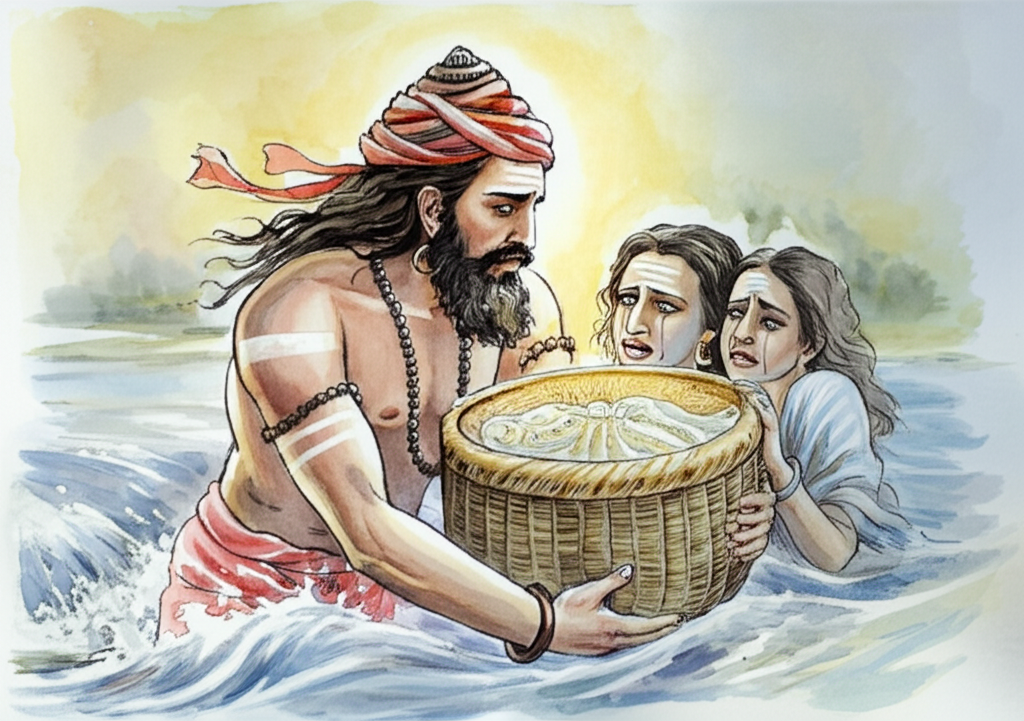
Then Goraknáth said that he had to leave, but first, he asked King Burtal to show him something amazing to prove his skill. King Burtal sent for a big iron chain from the blacksmith. Then he made a big fire. This scared the palace helpers, who wondered if he was going to burn down the palace and his wives! Next, King Burtal sent for some ghee (a kind of butter). “What is he going to do with the ghee?” said the palace helpers. Then he hammered a nail into the wall, rubbed his hands with the ghee, put the iron chain into the fire, and pulled it out red-hot! Flames were coming from the iron! King Burtal hung it on the nail and pulled and pulled at the chain until he pulled it off the nail. His hands didn’t get burned at all! The queens and palace helpers were super surprised, and Goraknáth was very happy. “You know how to do your work well!” he said to the king. Then Goraknáth said goodbye, telling him to take care of his kingdom and his wives. But they all said he shouldn’t leave, so they built him a big house in the yard and gave him lots of helpers and plenty of money. Goraknáth agreed to live in this house, but since he was a wise man, he often went off by himself to spend time in his jungle, always coming back to his house in King Burtal’s yard. Meanwhile, King Burtal gave each of his wives a líchí to eat. After a little while, each wife had a little son! They were all such beautiful children, but the biggest and most handsome of all was the eldest queen’s little son. His name was Sazádá, and his father and mother loved him very much.
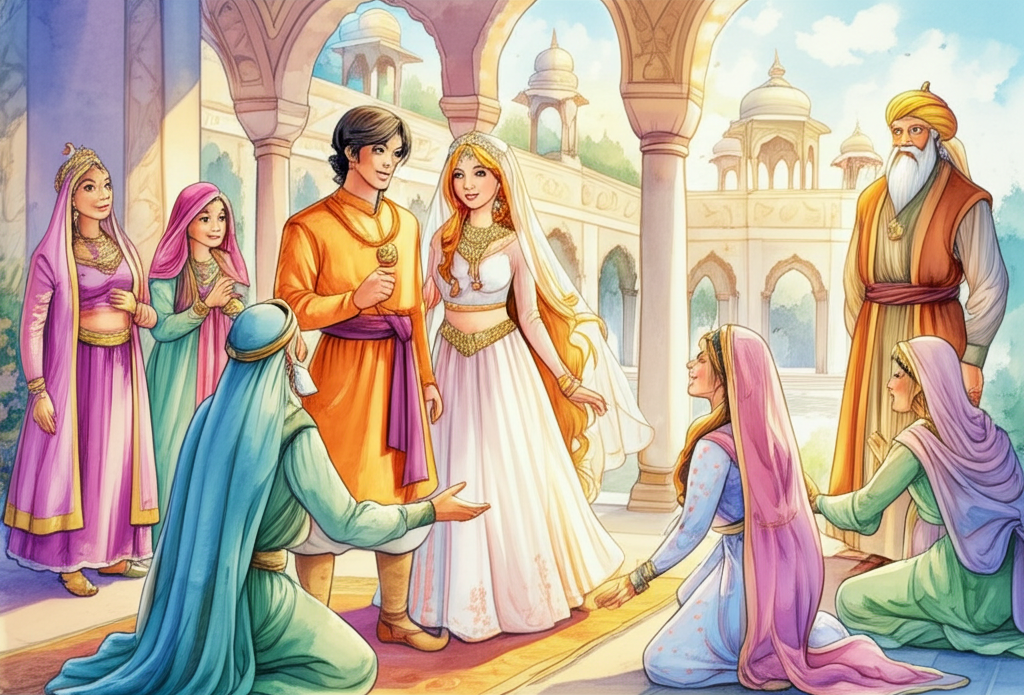
When Prince Sazádá was about six or seven years old, the wise man Goraknáth came to King Burtal and said, “Now you have to give me your son Sazádá, because I want to take him away with me for a few years.” The queen, his mother, didn’t want to let him go, but finally, she had to. She became sad and sick with worry.
Goraknáth took the little prince to a fairy place called Indrásan to be taught by the fairies. When they got there, he had him marry Jahúr Rání, who was the daughter of the most important fairy queen. Goraknáth had a big wedding for the little prince. All the fairies were happy that he was going to be Jahúr Rání’s husband. They thought he was a beautiful child and fell in love with him right away! They taught him how to play all kinds of musical instruments, sing beautifully, read, and write. He became more and more handsome every day in the fairy kingdom. Goraknáth came to see him often, and the fairies took great care of him.
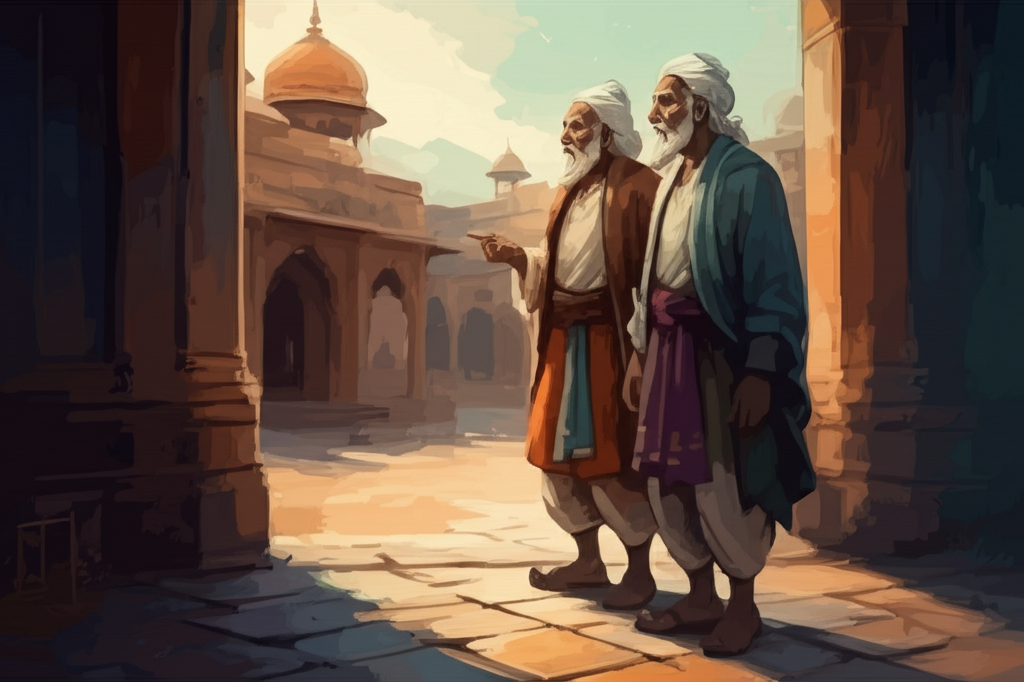
When Prince Sazádá had grown into a fine, strong young man, Goraknáth took him and his wife, Jahúr Rání, and brought them back to King Burtal’s kingdom in a grand way. First, he took the young prince and showed him to his father, saying, “See, here’s your son! Now he can read and write, sing, and play all kinds of instruments because I had him taught all these things!” But when they saw him, they fell to their knees because they couldn’t look at him because he was so handsome. He had become so handsome in Indrásan, and his cheeks were red. “How can this beautiful boy be our son?” they said, and they didn’t recognize him. “Stand up!” said Goraknáth. “This is your son Sazádá. Don’t fall down before your son!” So, they stood up, and the wise man said, “I’ve married your son to the fairy princess Jahúr Rání, and I’ll bring her to you.” Then he brought the little queen. When they saw her, they fell down again because they couldn’t look at her beauty! Her hair was like red gold, her eyes were dark, and her eyelashes were black! But Goraknáth made them stand up. When they really understood that it was their son and his wife that he had brought them, they took Prince Sazádá into their arms and kissed him and loved him, and his queen, too! Goraknáth had a big wedding party for them all, and they were all very happy!